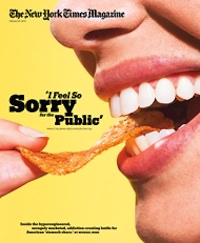How the Junk-Food Industry Is Getting You Addicted to Its Products
A New York Times report takes an in-depth look at the ways the junk-food industry ensures that you will get hooked on its "convenient" and "inexpensive" products.
Could you be addicted to junk foods and not even know it? That’s a likely possibility, according to a major exposé on the addictiveness of junk food. The cover story for the most recent New York Times Magazine takes an in-depth look at the ways the junk-food industry ensures that you will get hooked on its “convenient” and “inexpensive” products. Foods, it should be noted, that will lighten your wallet while expanding your waistline.
“The public and the food companies have known for decades now — or at the very least since this meeting [of food company CEOs] — that sugary, salty, fatty foods are not good for us in the quantities that we consume them. So why are the diabetes and obesity and hypertension numbers still spiraling out of control?” Michael Moss writes. “It’s not just a matter of poor willpower on the part of the consumer and a give-the-people-what-they-want attitude on the part of the food manufacturers. What I found, over four years of research and reporting, was a conscious effort — taking place in labs and marketing meetings and grocery-store aisles — to get people hooked on foods that are convenient and inexpensive.”
Esquire’s Eat Like a Man blog provided a succinct breakdown of the Times story.
Esquire:
A few ways companies are hooking you:
With math. In the wake of its Red Fusion failure, Dr Pepper hired a food optimization expert with a PhD in experimental psychology and a mathematical model used to pair ingredients like “Color 23,” “Syrup 11,” and “Packaging 6” in order to craft the most addictive product. Howard Moskowitz is basically the Nate Silver of packaged food.
With something called a “bliss point.”For Dr Pepper, Moskowitz tried to reach a something called the “bliss point,” the sweet spot between repeatable drink- or eat-ability and flavor (overpowering flavor can only be consumed so much before you get tired). In order to find it, his “formulas were then subjected to 3,904 tastings organized in Los Angeles, Dallas, Chicago and Philadelphia.” The data was then collated in a meticulous, 135-page report. The end result: Cherry Vanilla Dr Pepper.
By preying on your kids’ brains. Lunchables had a breakthrough when they realized, as CEO Bob Eckert is quoted, “Lunchables aren’t about lunch. It’s about kids being able to put together what they want to eat, anytime, anywhere.” Once they shifted the focus to kids instead of wearied mothers, Lunchables sales took off and have yet to stop.
To read the full New York Times Magazine article, click here.
Your support matters…Independent journalism is under threat and overshadowed by heavily funded mainstream media.
You can help level the playing field. Become a member.
Your tax-deductible contribution keeps us digging beneath the headlines to give you thought-provoking, investigative reporting and analysis that unearths what's really happening- without compromise.
Give today to support our courageous, independent journalists.






You need to be a supporter to comment.
There are currently no responses to this article.
Be the first to respond.